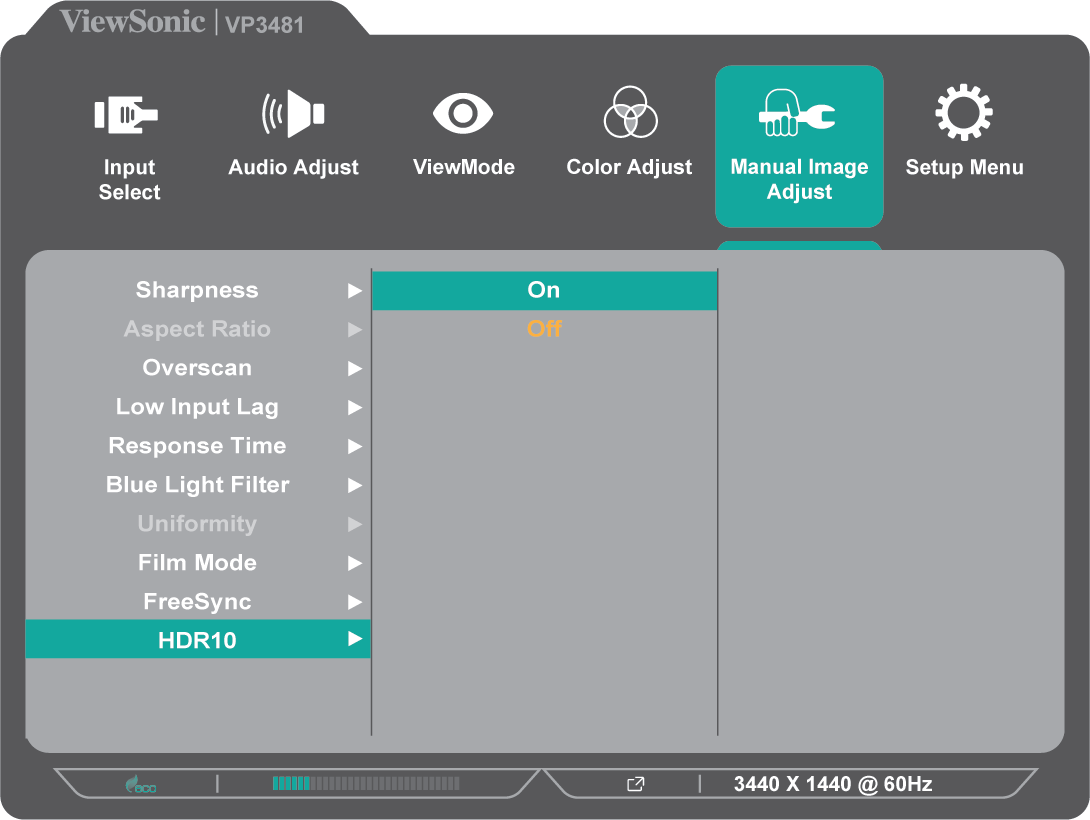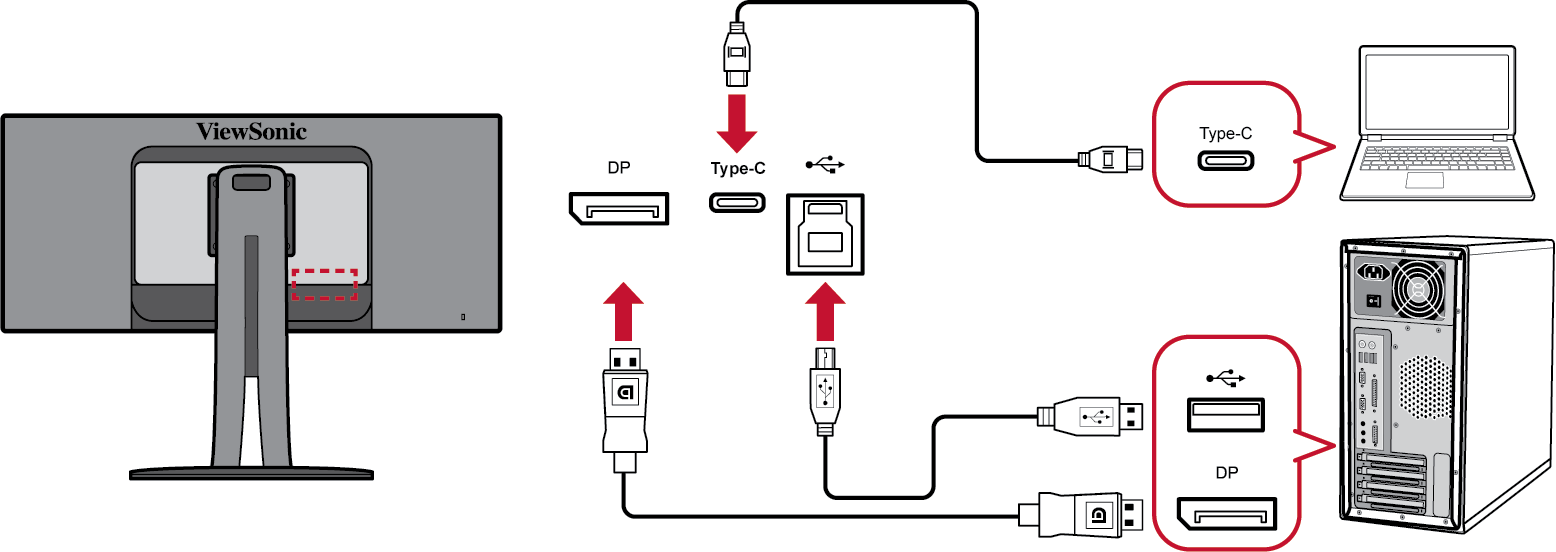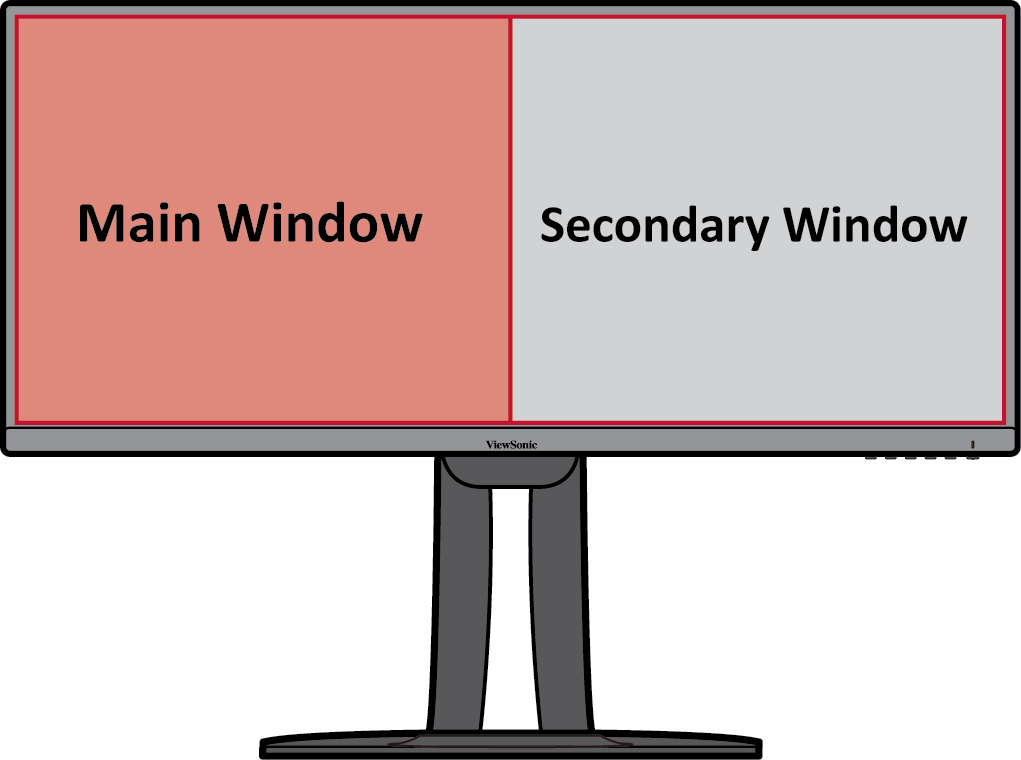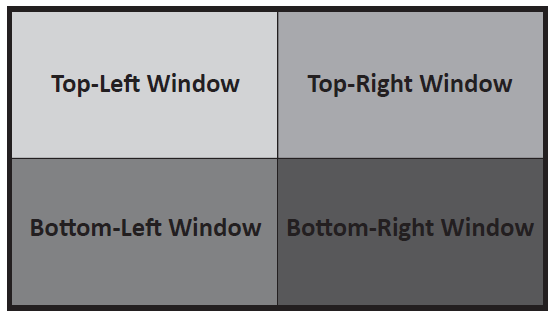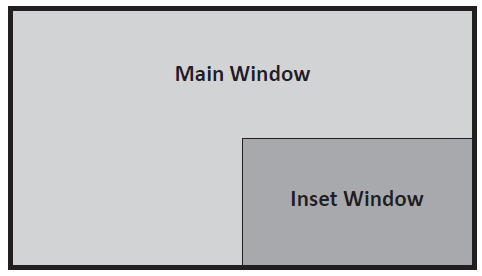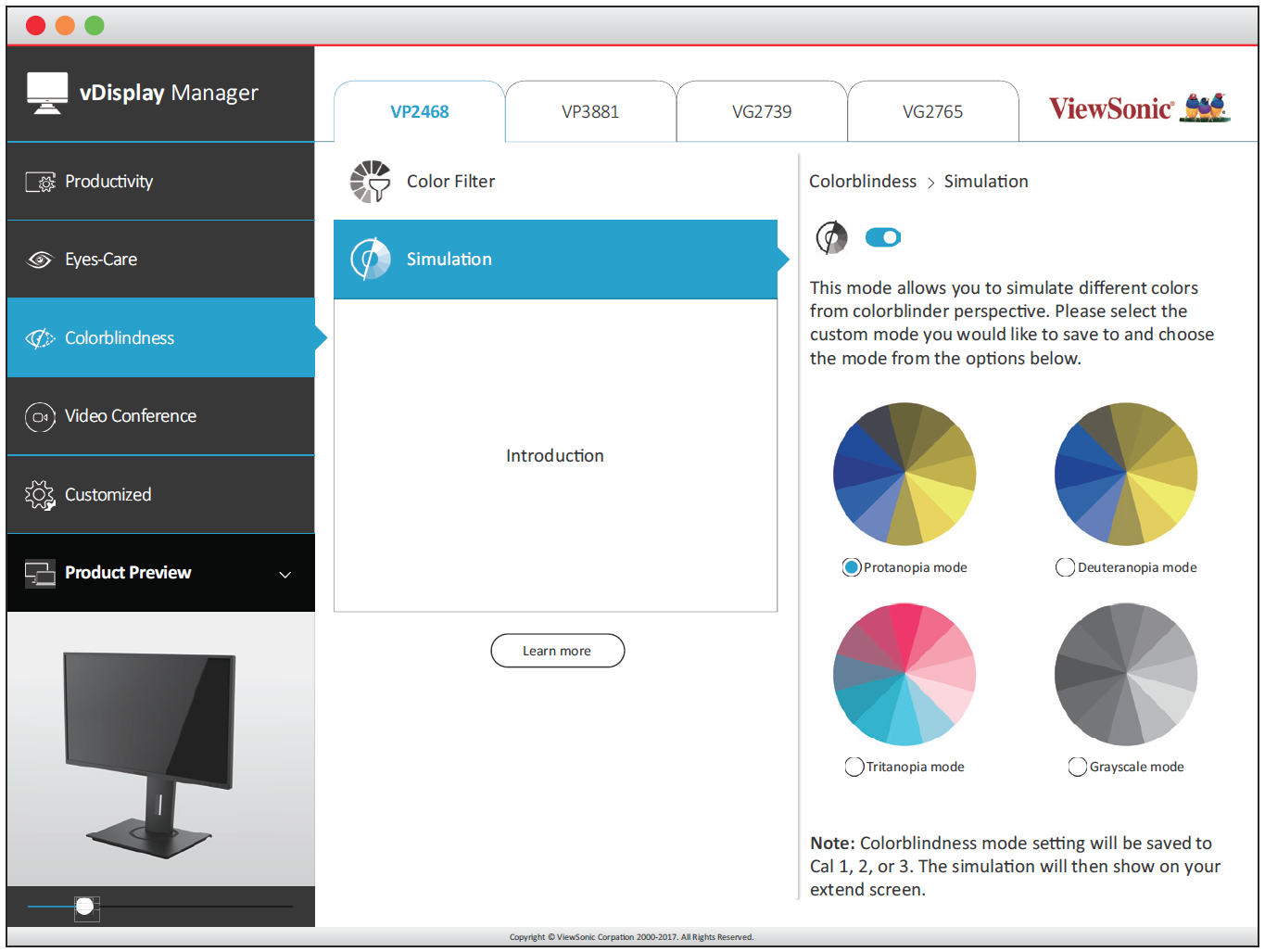VP3481a Advanced Features and Settings
HDR10 (High-Dynamic-Range)
Reduces the overall contrast of a given scene so that detail in the highlights and shadows can be seen.
- NOTE: Ensure the HDR setting is turned on on your device first before enabling the HDR10 on the monitor.
To enable the HDR10 function:
- Press the 1/2/3/4 key to display the Quick Menu. Then press the 4 key to display the OSD Menu.
- Press the 1 or 2 key to select Manual Image Adjust. Then press the 3 key to enter the Manual Image Adjust menu.
- Press the 1 or 2 key to select HDR10. Then press the 3 key to enter its sub-menu.
- Press the 1 or 2 key to select On. Then press the 3 key to confirm.
KVM
The KVM function allows the user to control two computers connected to the same monitor from a single keyboard and mouse.
- NOTE: Only applicable in PBP (Picture-by-Picture) mode.
To connect the two computers to the monitor:
- Connect one end of the USB Type C cable to the USB Type C port of the monitor. Then connect the other end of the cable to the USB Type C port of the notebook.
- Connect one end of a DisplayPort cable to the DisplayPort of the monitor. Then connect the other end of the cable to the DisplayPort or mini DP of the computer.
- Connect the USB Type B male cable (square with 2 cut corners) to the USB Type B port of the monitor. Then connect the other end of the cable to the USB port of the computer.
To enable PBP mode:
- Press the 1/2/3/4 key to display the Quick Menu. Then press the 4 key to display the OSD Menu.
- Press the 1 or 2 key to select the Setup Menu menu. Then press the 3 key to enter the menu.
- Press the 1 or 2 key to select Multi-Picture. Then press the 3 key to enter its sub-menu.
- Press the 1 or 2 key to select PBP Left-Right. Then press the 3 key to enable PBP mode.
To activate the KVM function:
- Press and hold the 1 key for one (1) second to activate the KVM function.
- Then you will be able to switch the cursor between the two screens (left/right window).
Dual Color
The monitor comes with a dual color engine to display two different color settings in PIP (Picture-in-Picture) or PBP mode. You can set different color presets in both windows (Main Window and Secondary Window).
To configure Dual Color:
- Press the 1/2/3/4 key to display the Quick Menu. Then press the 4 key to display the OSD Menu.
- Press the 1 or 2 key to select the Setup Menu menu. Then press the 3 key to enter the menu.
- Press the 1 or 2 key to select Multi-Picture. Then press the 3 key to enter its sub-menu.
- Press the 1 or 2 key to select Dual Color. Then press the 3 key to enter its sub-menu.
- Press the 1 or 2 key to select the desired color setting. Then press the 3 key to confirm.
Multi-Picture
Multi-Picture allows users to further customize their work space by allowing up to four split windows from different inputs, displaying high resolution content with different aspect ratios, without distortion from the original input sources.
To enable Multi-Picture mode:
- Press the 1/2/3/4 key to display the Quick Menu. Then press the 4 key to display the OSD Menu.
- Press the 1 or 2 key to select the Setup Menu menu. Then press the 3 key to enter the menu.
- Press the 1 or 2 key to select Multi-Picture. Then press the 3 key to enter its sub-menu.
- Press the 1 or 2 key to select Quad Windows, PBP Top-Bottom, PBP Left-Right, or PIP. Then press the 3 key to enter the selected mode.
Quad Windows
To specify the input source for each window:
- Press the 1/2/3/4 key to display the Quick Menu. Then press the 4 key to display the OSD Menu.
- Press the 1 or 2 key to select the Setup Menu menu. Then press the 3 key to enter the menu.
- Press the 1 or 2 key to select Multi-Picture. Then press the 3 key to enter its sub-menu.
- Press the 1 or 2 key to select Quad Windows. Then press the 3 key to enter its sub-menu.
- Press the 1 or 2 key to select the window of which you want to change the input source. Then press the 3 key.
- Press the 1 or 2 key to select the desired input source. Then press the 3 key to confirm.
PBP (Picture-by-Picture)
| PBP Top-Bottom | PBP Left-Right |
|---|---|
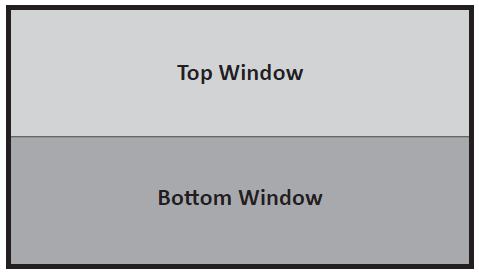 |
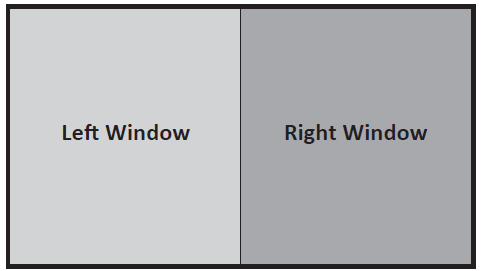
|
- NOTE: To display full-sized images in the windows, please adjust the screen resolution to 3840 x 1080 (for PBP Top-Bottom mode) or 1920 x 2160 (PBP Left-Right).
To configure PBP:
- Press the 1/2/3/4 key to display the Quick Menu. Then press the 4 key to display the OSD Menu.
- Press the 1 or 2 key to select the Setup Menu menu. Then press the 3 key to enter the menu.
- Press the 1 or 2 key to select Multi-Picture. Then press the 3 key to enter its sub-menu.
- Press the 1 or 2 key to select PBP Top-Bottom or PBP Left-Right. Then press the 3 key to enter its sub-menu.
- To change the input source, select the source location (Top Source/Bottom Source or Left Source/Right Source) and press the 3 key.
- Then press the 1 or 2 key to select the desired input source and press the 3 key to confirm.
- To swap the two windows, select Swap and press the 3 key to confirm.
PIP (Picture-in-Picture)
To configure PIP:
- Press the 1/2/3/4 key to display the Quick Menu. Then press the 4 key to display the OSD Menu.
- Press the 1 or 2 key to select the Setup Menu menu. Then press the 3 key to enter the menu.
- Press the 1 or 2 key to select Multi-Picture. Then press the 3 key to enter its sub-menu.
- Press the 1 or 2 key to select PIP. Then press the 3 key to enter its sub-menu.
- To change the input source for the Inset Window, select PIP Source Select and press the 3 key. Then press the 1 or 2 key to select the desired input source and press the 3 key to confirm.
- To adjust the Inset Window position, select PIP Position and press the 3 key. Press the 3 key to select PIP H.Position or PIP V.Position. Press the 1 or 2 key to adjust the setting and press the 3 key to confirm.
- To adjust the Inset Window size, select PIP Size and press the 3 key. Then press the 1 or 2 key to adjust the setting.
- To swap the two windows, select Swap and press the 3 key to confirm.
Colorbration+
To ensure long-term color accuracy, some specific models support the hardware color calibration function. The Colorbration+ application installation file can be found at: http://color.viewsonic.com/support/software/.
Standard monitor packing does not include the color sensor, which the Colorbration+ application needs for the calibration process.
Compatible color sensors include:
- X-Rite i1 Display Pro
- X-Rite i1 Pro 2
- X-Rite i1 Studio
- Xrite Colormunki Photo
- Xrite Colormunki Design
- Datacolor Spyder 5
- Datacolor SpyderX series
Colorblindness Mode
Through the vDisplayManager software, this display supports two Color Blindness modes:
- Color Filter
- Simulation
Users who are color blind can activate the Color Filter feature to better see on-screen details.
Designers can activate the Simulation feature to review their designs and verify they look color blind friendly.
NOTE: The vDisplayManager software can be downloaded at: https://color.viewsonic.com/support/software/
Firmware Update
For the best display performance and to resolve any known issues, it is best to keep your monitor updated with the latest firmware version. With the supplied USB cable and the vDisplayManager application, you can easily update your monitor’s firmware.
To update the firmware:
- Download and install the vDisplayManager application: https://color.viewsonic.com/support/software/.
- Connect the USB Type B male cable (square with 2 cut corners) to the USB Type B port of your monitor. Then connect the other end of the cable to the USB port of the computer.
- Launch vDisplayManager. Select the Advanced tab in the side menu.
- Click Update to check for any updates to your monitor’s firmware.
- Wait until the update process is complete (if applicable).
- NOTE: Any interruptions during the firmware update process may permanently damage your monitor. Do not disconnect the USB cable or turn off your PC and monitor.

